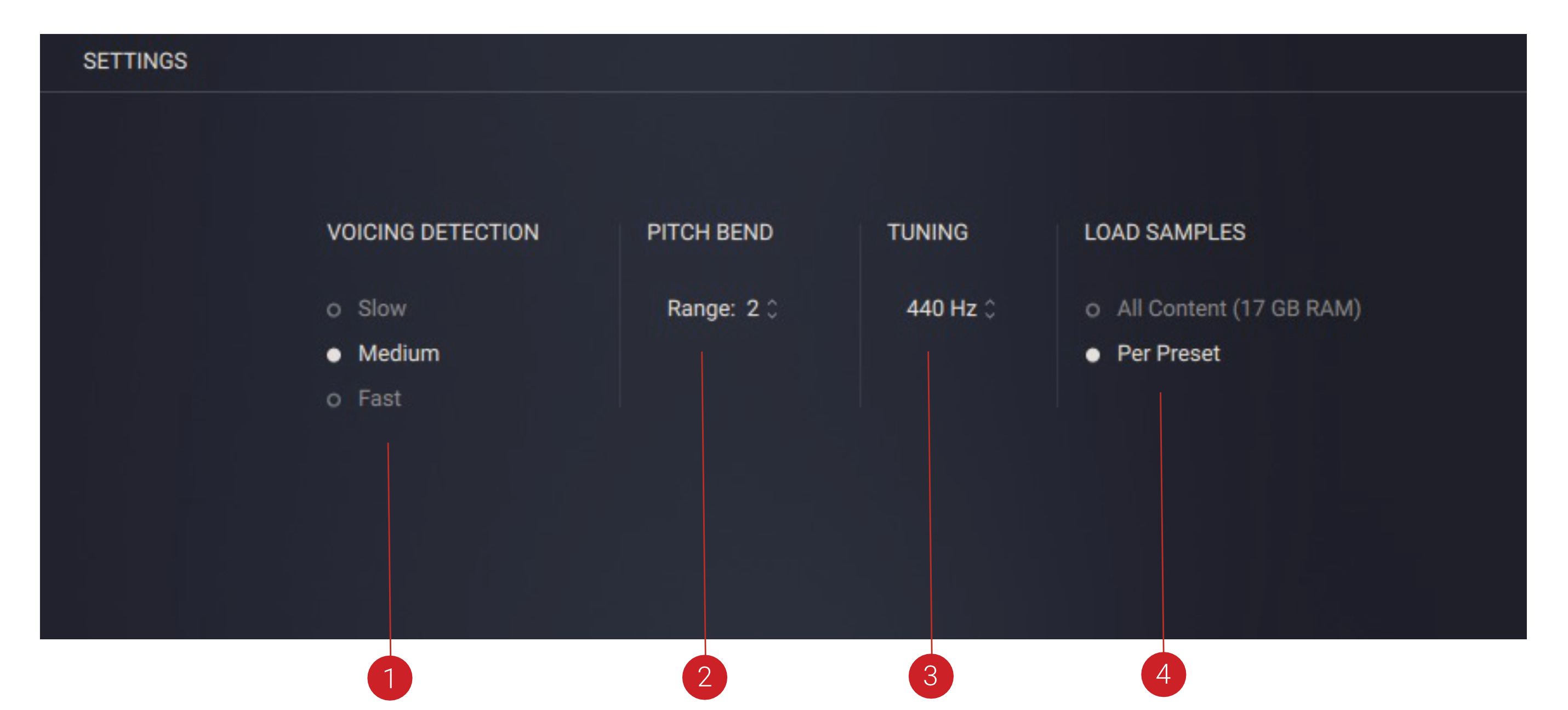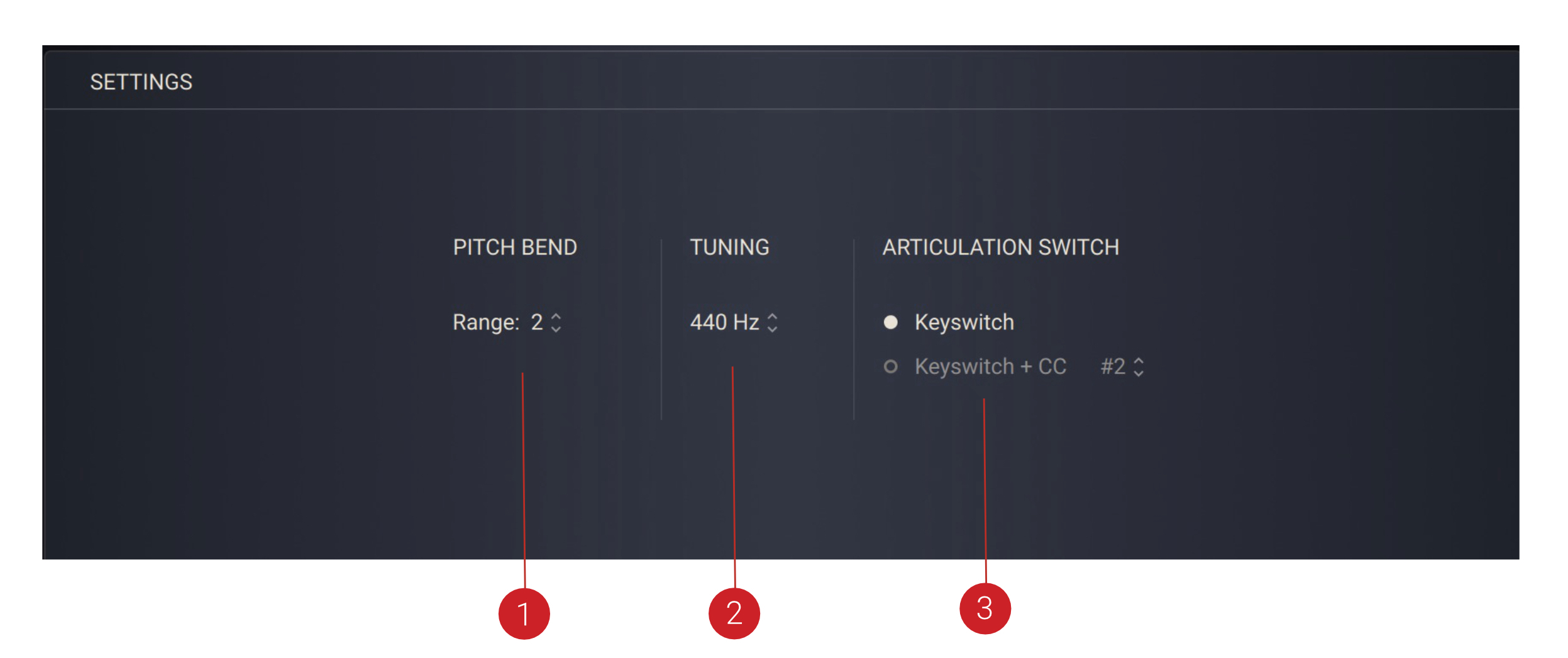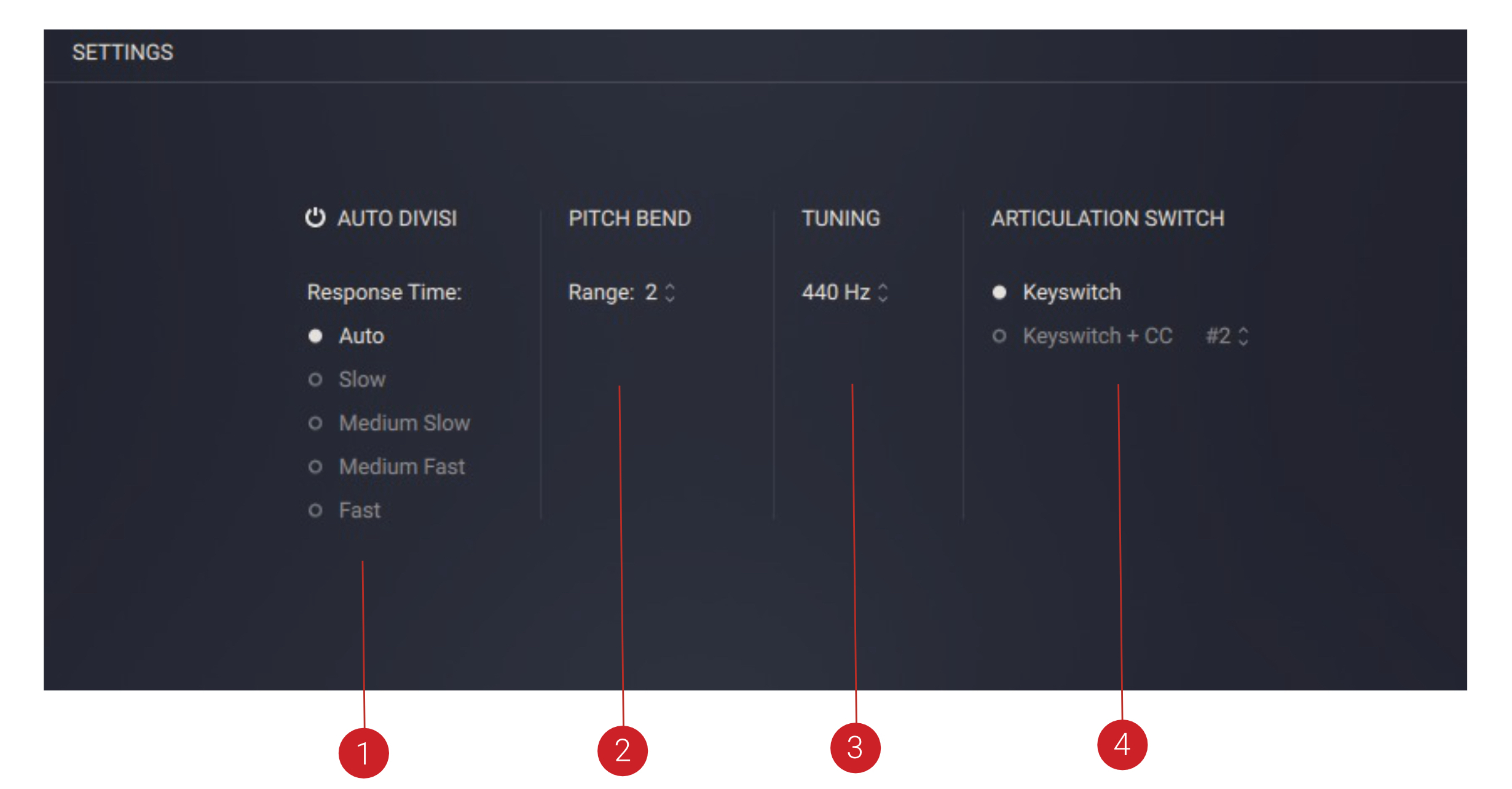Settings Page
The Settings page of Valves Pro is where you access global controls related to voice handling, pitch bend and tuning, as well as sample loading.
The Settings page is where you access global controls related to voice handling, pitch bend and tuning, as well as sample loading.
Settings Page in Valves Pro Player
The Settings page of Valves Pro Player contains the following controls:

Voicing Detection: Determines how quickly the engine interprets note input when distributing chords across the five instruments. The three timing options correspond to 24ms (Slow), 12ms (Medium) and 1ms (Fast). The Slow setting will accommodate less precise playing by registering a chord even when notes are not all pressed at exactly the same instant. The Fast setting requires chords to be played more accurately and is particularly suited to playing back quantized MIDI chords in your host with a minimum amount of latency.
Pitch Bend: Sets the range of the pitch bend wheel from one to seven semitones. This can be used to create effects from subtle vibrato to more extreme pitching effects.
Tuning: Sets the global tuning reference in the range from 420Hz to 460Hz. The default setting is concert pitch at 440Hz.
Load Samples: Determines the sample loading behavior. All Content results in faster switching between presets, however requires more RAM. Per Preset loads only the samples required for the chosen preset, which reduces the RAM usage but increases the loading times of presets.
Settings Page - Valves Pro Solo
The Settings page of Valves Pro Ensemble is where you access global controls related to pitch bend and tuning, as well as articulation switching.
The Settings page of Valves Pro Solo contains the following controls:

Pitch Bend: Sets the range of the pitch bend wheel from one to seven semitones. This can be used to create effects from subtle vibrato to more extreme pitching effects.
Tuning: Sets the global tuning reference in the range from 420Hz to 460Hz. The default setting is concert pitch at 440Hz.
Articulation Switch: Sets whether articulation slots are selected using keyswitches in Kontakt or via a specific MIDI CC command. If Keyswitch + CC is selected the range of the MIDI CC gets divided into 32 parts, each corresponding to an articulation slot. Slot 1 goes from CC value 0-4, slot 2 from 5-9 and so on.
Settings Page - Valves Pro Ensemble
The Settings page of Valves Pro Ensemble is where you access global controls related to pitch bend and tuning, as well as articulation switching.
The Settings page of Valves Pro Ensemble contains the following controls:

Auto Divisi: Sets the way in which incoming notes are distributed across the instruments. The options determine how quickly Valves Pro analyses and distributes the notes.
Pitch Bend: Sets the range of the pitch bend wheel from one to seven semitones. This can be used to create effects from subtle vibrato to more extreme pitching effects.
Tuning: Sets the global tuning reference in the range from 420Hz to 460Hz. The default setting is concert pitch at 440Hz.
Articulation Switch: Sets whether articulation slots are selected using keyswitches in Kontakt or via a specific MIDI CC command. If Keyswitch + CC is selected the range of the MIDI CC gets divided into 32 parts, each corresponding to an articulation slot. Slot 1 goes from CC value 0-4, slot 2 from 5-9 and so on.
Auto Divisi
The Auto Divisi and Response Time settings determine how Valves Pro Ensemble distributes notes to the five available instruments.
Auto Divisi introduces a number of great possibilities for playing the ensemble as a polyphonic section instrument and providing a highly natural feel:
You can stop and restart one or more voices at any time to play rests while keeping some other notes held. Since articulations can be mixed, this feature can be used to combine an accompaniment section, for example using staccato with a melodic section.
As a rule for the first notes played, the system always distributes the played notes to all instruments, doubling notes if needed. An instrument can be muted temporarily for a given key switch by assigning the articulation None.
When Auto Divisi as activated, the incoming notes of a chord are distributed across the instruments. Each instrument plays one note of the chord as this is the natural way of distributing notes across a brass section. The system distinguishes between chords and melodic lines. It also decides which instruments play in unison, or if an instrument rests or restarts again. The Response Time setting determines the time taken for the system to interpret notes as a chord. It is also related to the latency of the Auto Divisi system.
When Auto Divisi is deactivated, each instrument will play all the notes of a chord meaning each instrument plays polyphonically. Although this is less natural, it creates a bigger sound.
Tip
It is always possible to use the sustain pedal for convenient legato playing. In this case, a high latency setting is not required.
Response Time
The Response Time setting provides the following options:
Auto: This mode is selected by default and tries to combine a natural feel with the lowest possible latency. For the first key-downs a short response time is used, just long enough to make up a chord. If no legato articulation is used on the keyswitch, additional playing uses the Medium Fast mode. If at least one legato articulation is used on the keyswitch, additional notes use the Slow mode.
Slow: This setting is useful for manually playing or recording legato lines with more than one active instrument. Ff just one instrument is active, legato can also be played in Fast mode. It allows fluent manual playing and needs a higher latency but legato lines are smoother and unintended jumping of voices is prevented. This mode is also good for playing unison legato passages. The resulting latency is 72 ms.
Medium Slow: This setting can be used for legato playing too, if the MIDI passage is edited in a DAW to minimise note overlap. The resulting latency is 24 ms.
Medium Fast: This setting is recommended for short articulations. The resulting latency is 12 ms.
Fast: Uses a very short chord collection time with an ultra fast response. This setting is useful for quantized chords. The resulting latency is 1 ms.